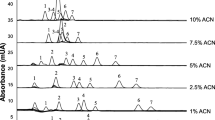Abstract
A quick method for obtaining empirical relative volatilities of congeners in relation to ethanol in wine-spirits systems is proposed. Wines with and without lees of fermentation were distilled in a static device similar to an equilibrium cell. Relative volatilities were deduced from vapour and liquid compositions when the system reached a stationary state. They strongly depended on the alcoholic strength but the quantity of lees was not influential. Data were employed to establish the partition factor of 10 characteristic congeners in the spirits obtained from sherries. Relative volatilities and partition factors were close to those obtained in equilibrium stills.






Similar content being viewed by others
Abbreviations
- B :
-
Concentration in bottoms
- D :
-
Concentration in distillates
- K :
-
Partition factor, volatility
- N :
-
Number of theoretical stages
- P :
-
Pressure
- P v :
-
Vapour pressure
- x :
-
Molar fraction in liquid
- y :
-
Molar fraction in vapour
- α:
-
Relative volatility
- γ:
-
Activity coefficient
- γ∞ :
-
Infinite dilution activity coefficient
- BP:
-
Boiling point
- cal:
-
Calculated
- exp:
-
Experimental
- eq:
-
Equilibrium
- E:
-
Ethanol
- W:
-
Water
- i:
-
Congener
References
Hala E, Pick J, Fried V, Vilim O (1967) Vapour-liquid equilibrium. Pergamon Press, Oxford, p 192
Ghemeling J, Onken U, Alt W (1981) Vapour- liquid equilibria data collection I/1a: E-W-Propanol, (Andiappan A, McLean AY, p. 550) (Metyushev BD, p. 551); E-W-Butanol, (Ikari A, Ayabe N, p. 563–564) (Newshamm DMT, Validat N, p. 565); E-W-3Methyl 1Butanol, (Andiappan A, McLean AY, p. 569–570) (Metyushev BD, p. 571). Dechema, Frankfurt/Main, Germany
Eckert CA, Sherman SR (1996) Measurement and prediction of limiting activity coefficients. Fluid Phase Equilib 116:333–342
Sandler SI (1996) Infinite dilution activity coefficients in chemical, environmental and biochemical engineering. Fluid Phase Equilib 116:343–353
Prausnitz JM, Lichtenthaler RN, Gomes de Acevedo E (2000) Termodinámica molecular de los equilibrios de fases. Apéndice F, 3rd edn. Prentice Hall, Madrid
Kojima K, Zang SJ, Hiaki T (1997) Fluid Phase Equilib 131:145–179
Leroi JC, Masson JC, Renon H, Fabries JF, Sannier H (1979) Accurate measurements of activity coefficients at infinite dilution by inert gas stripping and gas chromatography. Ind Eng Chem Process Des Dev 16(1):139–144
Sorrentino F, Voilley A, Richon D (1986) Activity coefficients of aroma compounds in model food systems. Am Inst Chem Eng J 32:1988–1993
Carelli AA, Crapiste H, Lozano JE (1991) Activity coefficients of aroma compounds in model solutions simulating apple juice. J Agric Food Chem 39:1636–1640
Sancho MF, Rao MA, Downing DL (1997) Infinite dilution activity coefficients of apple juice aroma compounds. J Food Eng 34:145–158
Athès V, Peña y Lillo M, Bernard C, Pérez Correa R, Souchon I (2004) Comparison of experimental methods for measuring infinite dilution volatilities of aroma compounds in water/ethanol mixtures. J Agric Food Chem 52:2021–2027
Athés V, Paricaud P, Ellaite M, Souchon I, Fürst W (2008) Vapour-liquid equilibria of aroma compounds in hydroalcoholic solutions: measurements with a recirculation method and modelling with the NRTL and COSMO-SAC approaches. Fluid Phase Equilib 265:139–154
Recueil de méthodes internacionales d′analyze des boissons spiritueuses des alcohols et de la fraction aromatique des boissons (1994). Office Internacional de la Vigne et du Vin. Editorial du Castillet. Paris
Williams LA (1962) Vapor-liquid equilibria of organic homologues in ethanol-water solutions. Am J Enol Vit 13:169–180
Gerogiannaki-Christopoulou M, Kyriakidis NV, Athanasopoulos PE (2006) The evaluation of grape pomace distillates from selected red grape varieties. Int J Food Sci Technol 41:854–860
Gerogiannaki-Christopoulou M, Komaitis ME, Stavrakas DE, Polysiou M, Athanasopoulos PE, Spanos M (2007) Evaluation of acetaldehyde and methanol in Greek traditional alcoholic beverages from varietal fermented grape pomaces. Food Control 18:988–995
Ikari A, Kubo R (1975) Behavior of various impurities in simple distillation of aqueous solutions of ethanol. J Chem Eng Jpn 8:294–299
Guymon JF (1974) The sensory character of brandy. Wines Vines 35:28–29
Unger CD, Coffey TR (1975) Production of light-bodied rumby an extractive distillation process. Ann Technol Agric 24:469–495
Chandrasekaran SK, King CJ (1971) Retention of volatile flavor components during drying of fruit juices. Chem Eng Symp Ser 67(108):122–130
Author information
Authors and Affiliations
Corresponding author
Rights and permissions
About this article
Cite this article
Martín, A., Carrillo, F., Trillo, L.M. et al. A quick method for obtaining partition factor of congeners in spirits. Eur Food Res Technol 229, 697–703 (2009). https://doi.org/10.1007/s00217-009-1104-2
Received:
Revised:
Accepted:
Published:
Issue Date:
DOI: https://doi.org/10.1007/s00217-009-1104-2




